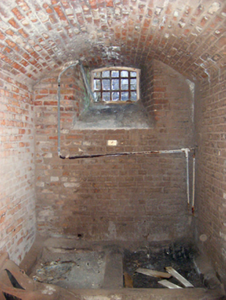Survey Data
Reg No
20908784
Rating
Regional
Categories of Special Interest
Architectural, Historical, Social, Technical
Previous Name
Fort Westmoreland originally Westmoreland Fort
Original Use
Prison/jail
Date
1800 - 1820
Coordinates
180272, 64513
Date Recorded
06/09/2007
Date Updated
--/--/--
Description
Detached four-bay two-storey prison, built c. 1810, having single-bay single-storey wings to east and west elevations and two-bay single-storey extension to rear (north) elevation. Now disused. Limestone parapet with cornice to roofline. Ashlar limestone walls having limestone plat band, string course and plinth course. Carved cornices to wings. Camber-headed window openings with limestone sills, some having cast-iron bars. Square-headed door openings. Brick barrel vaulted ceiling and brick walls to interior having cantilevered limestone staircase leading to timber balcony with cast-iron brackets having trefoil motifs. Barrel vaulted cells, some with timber battened doors having cast-iron locks.
Appraisal
Solidly built former prison displaying high quality design and detailing. The finely cut limestone walls and dressings are indicative of the skill of nineteenth century craftsmen. Retaining its original form and interior plan, the building serves as a valuable reminder of the nineteenth century penal system. In 1847, Spike first became a convict depot. It was here in 1848 that John Mitchell, Irish nationalist activist and political journalist, was held on his way to Van Diemen’s Land. Mitchell’s classic Jail Journal, one of Irish nationalism’s most famous texts, was written, some say, while he was imprisoned at Spike.













